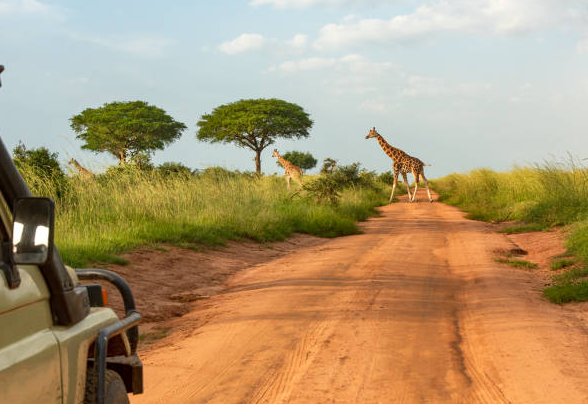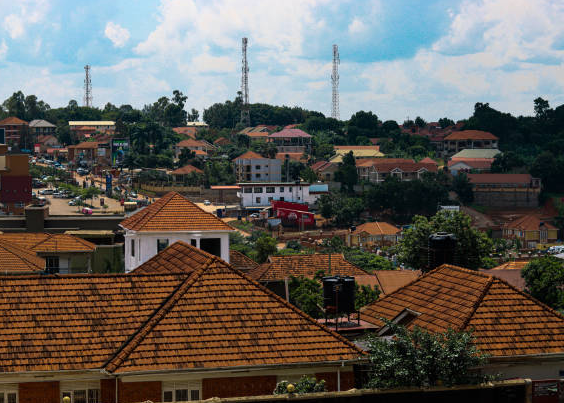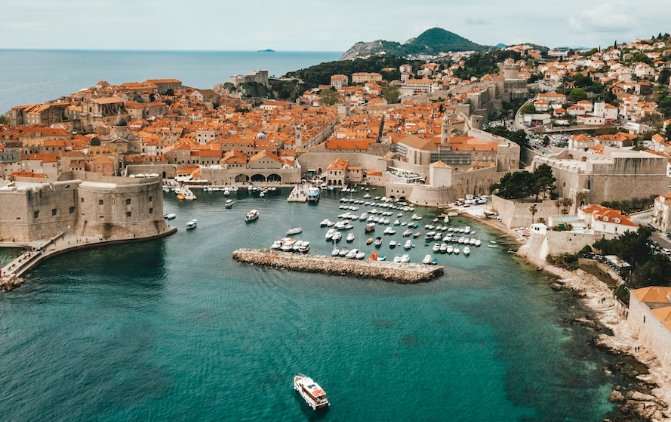The Ultimate Guide to Travel Planning in Uganda

America’s Best Bavarian Villages – Enjoy the Scenery and the Food!
December 8, 2024
Riverside Cabins in Colorado
December 18, 2024So are you thinking of an adventure to Uganda? That’s great! Uganda is home to some unbeatable natural landscapes, such as Lake Victoria, the second largest lake in the world and the largest tropical lake! This East African country is also home to more than 1,000 species of birds and 10 national parks, providing the perfect setting for mountain gorillas, elephants, giraffes, crocodiles, and many other animals. It is safe to say that Uganda is one of the best African countries to see the natural landscapes of Africa and see a large number of animals.

Although Uganda is one of the fastest growing countries in Africa, it is still a developing country, which makes some tourists nervous about planning a safari in Uganda. Well, that’s where our Road Affair comes in! We’ve crafted this ultimate guide to planning a safari in Uganda so that you can leave all your worries behind and plan the perfect vacation. We’ll cover visa and health requirements, what to bring, the best time to book your trip, and even the best places to visit when you travel. Whether you want to go on a budget or luxury safari in Uganda, below you’ll find everything you need to plan your trip!
What Makes a Uganda Safari Unique
Uganda is known as the “Pearl of Africa” for its natural beauty and abundant wildlife. Not only does it have countless beautiful landscapes, but it is also the country with the largest number of primates in the world. If you want to get up close and personal with mountain gorillas and enjoy Jane Goodall-like moments, then look no further than Uganda as it is one of only 10 countries in the world where you can easily see these primates.
Several other large animals also call Uganda home, including the African bush elephant, the African buffalo and the African lion. Uganda also has more fresh water than any other African country. In fact, 26% of the country is covered by lakes and rivers, perfect for boat trips!
Visa Requirements to Travel to Uganda
The visa requirements for Uganda depend on the nationality of the passport you hold, but anyone wishing to enter Uganda for tourism will need to obtain a tourist visa. You can fill out the form on the official website here.
You should personally check your passport requirements on the official immigration website as entry requirements in Uganda are always changing. Regardless of which country’s passport you have, the passport must still be valid for at least six months from the date of your arrival. From 2023, Uganda requires a valid passport, a passport-sized photo, travel itinerary and accommodation reservations, travel plans and proof of yellow fever vaccination as required for a single-entry tourist visa.
Vaccination requirements in Uganda
To enter Uganda, you must be vaccinated against certain diseases (this is Africa, after all). While you will need to show proof of yellow fever vaccination to get a tourist visa, the CDC and the World Health Organization recommend vaccination against several other diseases before traveling to Uganda, including typhoid fever, hepatitis A and B, rabies, and meningitis (Uganda has been vaccinated in some dry-season meningeal hot spot areas).
You should also get malaria medicine from your doctor. In any case, you definitely need to see a doctor before flying to Uganda! They can advise you on vaccinations and carrying your medication with you.
While travel insurance is not mandatory upon entry, the Ugandan government and Road Affair strongly recommend that you purchase travel insurance. You never know what to expect on a safari in Africa, and you’re probably miles away from the nearest hospital. It’s best to purchase travel insurance in advance to reduce your stress (and potentially save thousands of dollars in medical bills). We recommend SafetyWing, which offers coverage for as low as $10 per week. You can get a fast, non-binding quote below.

What to Bring on a Safari in Uganda
When packing for your Uganda safari, you should be well prepared for a trip to remote areas and pack everything in a minimalist way. Yes, it sounds a bit contradictory, but if you pack up smartly, it’s doable. Here are the top five items we recommend you bring with you on your Uganda safari:
- Durable backpack. The first thing you need to do when planning your trip to Uganda is to buy a durable and comfortable backpack that will have everything you need! You can check out our list of the best travel backpacks here.
- Telescope. We recommend that you bring a set of binoculars so you don’t miss any of the animals on the safari. Check out our recommendations for the best compact travel binoculars here.
- First aid kit. A good first aid kit is a must when you travel anywhere. At a minimum, your kit should include ibuprofen (and any other medications you take), bandages, antibacterial ointments, antibacterial wound cleaners, gauze, insect bite cream or gel, medical tape, and alcohol pads.
- Purify water bottles. You won’t have quick access to drinking water during the trip, so it’s best to bring a water bottle that can filter out bacteria and viruses. This is especially handy if you get lost in the jungle or get separated from your group. See our list of top water purifiers for backpacking.
- Clothes for the cold. Although Africa is known for its heat, the mornings can actually be cool. It’s best to bring a light jacket, long pants, and warm socks for an early morning adventure!
- Also pay attention to the color of the clothes you are carrying. Red and yellow are associated with political parties in the area, so you may be targeted for wearing these colors.
Security in Uganda
While Uganda is a beautiful country with friendly locals, there are some travel recommendations you should pay attention to. First, Uganda borders several other African countries, including South Sudan. South Sudan’s 50-kilometer (about 31-mile) border is currently at high risk due to the terrorist activities of insurgent groups. The U.S. Department of State advises visitors to avoid the area unless you’re traveling to a national park with a reputable guide. The same travel advice applies to within 50 kilometers of the border of the Democratic Republic of the Congo.
Travelers should also know that Uganda passed an “anti-homosexual” bill in 2023 that makes it illegal to have sex with people of the same sex. While the bill is still under discussion, members of the LGBTQ+ community should exercise extreme caution when visiting.
Best Time to Book a Hunting Trip in Uganda
Uganda has a tropical climate, which means two dry seasons and two rainy seasons. The best time to visit is one of the dry seasons – December to February and June to August. The weather is best at this time and you will have a better chance of seeing mountain gorillas and other large animals as these are concentrated around puddles. Animals will also be easier to track because hiking trails won’t be washed away by rain.
However, if you want to save money on a Uganda safari, consider booking during the low season in October. You will find deals on accommodation and tours, but the downside is that it can rain.
Where to Go on a Safari in Uganda
Uganda has 10 national parks, each with its own unique features. Whether you’re most interested in lush jungles, mountains or waterfalls, these are our top picks for Uganda’s safari spots.
Go on a gorilla hike through the hard-to-cross forest in Bwindi
One of Uganda’s best gorilla trekking parks is the Bwindi Forest, home to nearly half of the world’s mountain gorillas. This national park is located in the west of the country, bordering the Democratic Republic of the Congo. Getting there is quite a long journey in itself, as it is about a 12-hour drive from the capital, Kampala.
A guided walk through this jungle is an unforgettable experience, with lush forests and a variety of wildlife offering amazing views. However, jungle treks are not easy, especially when you want to look for mountain gorillas. Bwindi’s gorillas don’t have GPS tags, so guides have to rely on their tracking skills. This means that it may take hours to find them, but when you find them, it’s all worth it!

You need to purchase a license to watch the gorillas in advance, which costs around $700. While this may sound like a huge expense, it’s actually cheaper than a gorilla license in neighboring Rwanda, which includes park admission, parking, ranger fees, advanced tracker fees, and gorilla viewing fees. About 75% of the cost of admission goes to protecting the park’s gorillas.
Guided tours in the park usually last two to three days, giving you plenty of time to see mountain gorillas. Another popular option is the joint tour, which next takes you to Queen Elizabeth National Park as it is only a four-hour drive from Bwindi.
If you want to see the gorillas in Bwindi, consider joining a three-day hike. The booking of this 5-star tour covers all transportation, accommodation, food, and gorilla trekking permits!
Best Hotels Near Buendi’s Impenetrable Forest: If you’re looking for quality accommodation near Bwindi, consider Karungi Camp. This homely hotel and campground offers an airport shuttle, an on-site bar and restaurant, and free Wi-Fi.
Look for tree-climbing lions in Queen Elizabeth National Park
Located off the border of the Democratic Republic of Congo, Queen Elizabeth National Park is one of the most popular hunting spots in Uganda. It is one of only two places in the world where tree-climbing lions can be spotted and is home to chimpanzees, hippos, elephants and zebras. There are several great cottages in the park and the roads are well maintained.
The park’s most popular tour is the three-day Savanna and River Safari, which includes hippopotamus watching by boat, chimpanzee tracking, and elephant and buffalo drives. There are also some unique ways to tour the park, including a hot air balloon ride that lets you float over the plains of Africa! For a one-of-a-kind experience, you can even live with the park’s local tribes, who harvest salt from nearby Lake Kawi and often perform energetic dances and performances.
This two-day safari in Queen Elizabeth National Park is the perfect tour to experience the park. The cost includes transportation, meals, lodging, and all park fees.
Best Hotels Near Queen Elizabeth National Park: If you’re planning a few nights in the park, you can’t go wrong with Queen Elizabeth Bush Lodge. This fantastic hotel is the ideal safari getaway with free breakfast and the chance to see elephants outside your room!
Track chimpanzees in Kibale Forest National Park
One of Africa’s most popular safaris is the chimpanzee trek in Kibale Forest National Park, which has the largest number of primates on the continent. The park is about a five-hour drive from Kampala and just a few hours drive from Queen Elizabeth National Park.

You’ll find plenty of playful monkeys in Kibaale’s jungle, home to 13 species of primates, including Khost monkeys, blue monkeys, red-tailed monkeys, and Africa’s most abundant red colobus monkeys. You can also see more than 325 species of birds as you hike along numerous hiking trails and cultural trails.
While this park is obviously perfect for monkey trekking, you won’t be chasing elephants and hippos here. Kibaale is not home to many large animals, so this safari is often bundled with a trip to Queen Elizabeth National Park to see rare climbing lions and other large wildlife. Another amazing natural attraction near Kibale is the crater lake in the neighboring city of Fort Portal.
Best hotels near Kibale Forest National Park:Isunga Lodge is undoubtedly the best place to stay near Kibaale. The hotel offers excellent facilities including an outdoor pool, an on-site restaurant and bicycle rental. The hotel is ideally located just a 20-minute drive from the Kanyanchu Visitor Centre in Kibale.
See mountain gorillas in Mkasinga Orangutan National Park
Mkasinga Orangutan National Park is one of two incredible national parks where you can see Uganda’s mountain gorillas. Located at the southwestern tip of the country, bordering Rwanda and the Democratic Republic of Congo, it’s not as popular as Bwindi and other parks, but if you want to see mountain gorillas, it’s definitely a closer look on your bucket list.
The park’s landscape includes three extinct volcanoes as well as mountain forests and woodland ecosystems that are home to forest elephants, jungle pigs, buffaloes, and a variety of birds. Mgasinga is also known for its population of golden snub-nosed monkeys and offers treks to find these fun, lively primates. The permit to track mountain gorillas here costs the same as Bwindi’s permit($700), but the golden monkey’s trekking permit is much cheaper, at around $60 per person.
The gorilla hike in Mgasinga may last between two and eight hours, depending on where the gorilla is on the day. These hikes are also quite dangerous for children, so they are only open to those aged 15 and up.
Best Hotels Near Mkasinga Orangutan National Park: If you’re planning to spend a few days in Uganda’s southernmost park, consider booking Ntebeko Homestay to stay with locals from the neighboring town of Kisoro. The accommodation includes breakfast (English and Irish) and a beautiful garden.
Chase Falls and Hippopotamus in Murchison Falls National Park
While in Uganda, you can’t miss Murchison Falls National Park. It takes three to six hours to get anywhere from Kampala but well worth the drive. In this famous national park, you’ll find the world’s most powerful waterfall, with the equivalent of 200 bathtubs per second rushing through a 7-meter-wide canyon! You’ll also have the chance to see hippos, chimpanzees, rhinos, cheetahs, Rothschild giraffes, and rare whale-headed storks.

There are plenty of activities to book in the park, including hot air balloon tours, launch tours to see hippos and crocodiles, cultural tours, chimpanzee trekking and bird watching tours. You can also follow several hiking trails to see primates and tropical birds. If you want to go bird watching specifically, the rainy season is the best time to visit Murchison Falls.
If this sounds like your favorite place, consider booking a two-day safari at Murchison Falls National Park and Ziwa Rhino Sanctuary. This tour includes all transportation, park tickets, accommodation, meals, water, and guided tours.
Best hotels near Murchison Falls National Park:Kikonko Lodge is the best place to stay during your Murchison safari. This 4-star hotel offers delicious breakfast options (à la carte and cooked-to-order), an outdoor pool and bike rental.
Bird watching in Lake Mbro National Park
Another great stopping point for a Uganda safari is Lake Mbro National Park. Although it is the smallest national park in the country, this wetland reserve is one of the best places for bird watching in Uganda. It is home to more than 350 species of birds, as well as hyenas, buffaloes, leopards, hippos and zebras. You can explore the park by car or boat, or you can walk without worrying about lions or elephants!
In addition to bird watching, you can do several adventurous activities at Lake Mbro, including nocturnal wildlife leopard watching, boat wildlife watching hippos and crocodiles, horseback riding excursions, and walking around the village to meet the locals. The park is located in the southern region of the country, about a 5-hour drive from Kampala, so you can also conveniently watch mountain gorillas in a bundle with Bwindi or Mgasinga.
If you want a day safari in Uganda, book a full-day safari at Lake Mbro. This tour includes an equator tour and a park cruise to see hippos and crocodiles.
Best hotels near Lake Mbro National Park:Hyena Hill Lodge is a must-stay outside of Lake Mburo. It offers a range of beautiful classic cottages, an on-site bar and restaurant and stunning mountain views.
A safari in Uganda is a once-in-a-lifetime adventure and now you know everything you need to book the ultimate vacation in Uganda. Before you know it, you’ve gone deep into the African jungle, just feet away from mountain gorillas and other beautiful animals. Can we say how jealous we will be?



